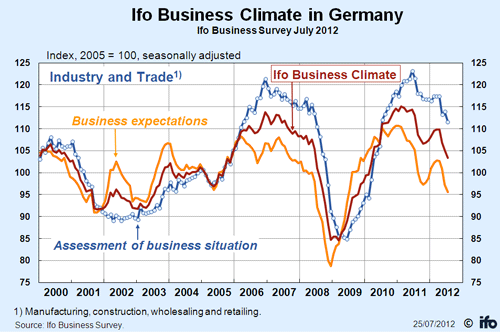Germany is the key to the euro. The homogenized currency provided them with a labor cost advantage that has been the engine behind the robust export economy (a la China, Japan before 1986, etc). In fact, the original sin of the euro (apart from the very notion of unelected supranational authority) was mispricing the D-mark into the euro schematic. That gives the Germans a lot of incentive to remain within the currency framework – no matter how they might protest open-ended commitments to the borrowers of the south, the euro provides economic activity and jobs to Germans (at the expense of Spaniards, Italians and Greeks). The trade-off from the German perspective is the financial imbalance that is created through the merchandise surplus ending up in the current account surplus. Before 2011 that meant German banks recycling euros into southern European subsidiaries or directly into PIIGS sovereign debt.
With the current account recycle broken post-2011, this is now a Bundesbank problem as Target II grows geometrically (at least through May, June slowed noticeably). So the merchandise surplus that creates jobs comes with a financial cost that is largely unmarked to any real “value”, i.e., hidden financial losses at Bubba. That dynamic will stay in place until 1. potential financial losses overwhelm German voter sentiment; 2. the financial losses actually overwhelm bank flows in Germany as money flees to Switzerland, Denmark, USD and yen; or 3. the merchandise imbalance no longer produces jobs because the financial toll on the other end (within the “periphery”) is too large to maintain the export economy of Germany.
We know that #1 is happening, but it is only sentiment that has not been validated in any truly meaningful sense except some electoral defeats for Merkel’s party in local elections. #2 is still just conjecture and potential, and as long as the ECB plausibly defends the euro the Bundesbank can end up with a geometrically rising surplus of euros without serious disruption. However, the larger that number grows the more skittish voters get and #1 becomes more problematic. There is a limitation to the financial exposure of South to North, but it is clear that limit is still in the future. #3 is much more problematic and closer at hand. We know that there is wanton economic destruction in the periphery due to the structural imbalances imposed by the rigidity of the homogenous currency, but the blowback into Germany is very real and very immediate.
To wit:
Reduced auto production and sales
http://www.kba.de/cln_030/nn_
“Subaru and Land Rover to benefit from the upward trend in the SUV, and recorded an increase of 175.7 percent and 119.1 percent. Audi was able to record with +14.3 percent increase also above average. It was very heavy losses at Opel (-18.6%), BMW, Mini (-17.9%) and Mercedes (-14.6%). Ford meets with a decline of 4.4 percent in about the average trend. The loss at VW’s highest-volume brand as (market share: 23.6%) is -1.5 percent. For the importers, there was loss of up to -70.9 percent (Daihatsu). But here, too many brands could significantly improve their previous year’s results, such as Chrysler, Jeep, Dodge (+55.3%).”
Business sentiment hit a cliff in the latter half of 2011
http://www.cesifo-group.de/
PMI back to 2009 levels:
http://www.markiteconomics.
“The performance of the German manufacturing sector took another turn for the worse in July, with output and new orders both declining at the sharpest rates since April 2009. This led to a further drop in the seasonally adjusted final Markit/BME Germany Purchasing Managers’ Index® (PMI®) – a composite index designed to give a snapshot of operating conditions in the manufacturing economy – from 45.0 to 43.0 in July, its lowest level since June 2009.
“Reduced production volumes have now been recorded in each of the past four months. The steep fall in output levels during July was driven by a marked decline in the investment goods sector. Anecdotal evidence widely attributed lower production to a lack of incoming new work to replace completed projects.”
The financial imbalances and current account flows out of the periphery (and even out of the euro entirely) are where attention is focused, but Germany can only maintain the mess as long as the real economy is “benefiting” from the export orientation. If the German economy is pulled down by the rot in the periphery, what meaningful sense will it make to maintain the potential financial cost of remaining? Of course there will always be political considerations, but if the economy is sinking into the abyss anyway it just may make sense to cut ties and alleviate the dual threat of economic collapse concurrent to exponentially growing financial and currency risks. The euro ends where the growing and actual German economic depression equals perceptions of what that economic depression might look like from leaving the euro.


Stay In Touch